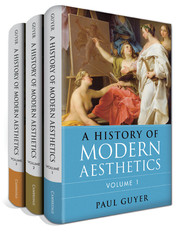Book contents
- Volume 1 The Eighteenth Century
- Volume 2 The Nineteenth Century
- Volume 3 The Twentieth Century
- Frontmatter
- Contents
- Acknowledgments
- Introduction
- Part One German Aesthetics in the Twentieth Century
- Part Two Aesthetics in Britain until World War II
- Part Three American Aesthetics in the First Half of the Twentieth Century
- Part Four Wittgenstein and After
- Bibliography
Part Three - American Aesthetics in the First Half of the Twentieth Century
from Volume 3 - The Twentieth Century
Published online by Cambridge University Press: 05 June 2015
- Volume 1 The Eighteenth Century
- Volume 2 The Nineteenth Century
- Volume 3 The Twentieth Century
- Frontmatter
- Contents
- Acknowledgments
- Introduction
- Part One German Aesthetics in the Twentieth Century
- Part Two Aesthetics in Britain until World War II
- Part Three American Aesthetics in the First Half of the Twentieth Century
- Part Four Wittgenstein and After
- Bibliography
Summary
This part will discuss American aesthetics from George Santayana to Nelson Goodman, while the final part of this volume will discuss Anglophone aesthetics, mostly but not entirely American, after the impact of Wittgenstein. The boundary lines of the present part are not neat. First, it will begin not in 1900, but with George Santayana’s first book, The Sense of Beauty, which was published in 1896. Other work from the 1890s or even from the first years of the twentieth century, such as works of Bernard Bosanquet, Karl Groos, Vernon Lee, and Ethel Puffer, have been included in the nineteenth century, but there are several reasons for including Santayana in the twentieth. For one, there was no tradition of academic aesthetics in America in the nineteenth century to which he could be attached, but Santayana inaugurated the vigorous pursuit of aesthetics in American philosophy departments in the twentieth century. Thus he should be seen as a starting point, not an end point. For another, there is the fact that he was a young man when he published The Sense of Beauty, and even though that remains his best-known work in aesthetics, the bulk of his work, including more work in aesthetics, was to come in the twentieth century – after all, he lived until 1952, thus dying a year later than the thoroughly twentieth-century Ludwig Wittgenstein. And finally, Santayana explicitly rejected what he saw as the metaphysical aesthetics of German Idealism and thus saw himself as a man of a new rather than an old century.
- Type
- Chapter
- Information
- A History of Modern Aesthetics , pp. 235 - 237Publisher: Cambridge University PressPrint publication year: 2014



